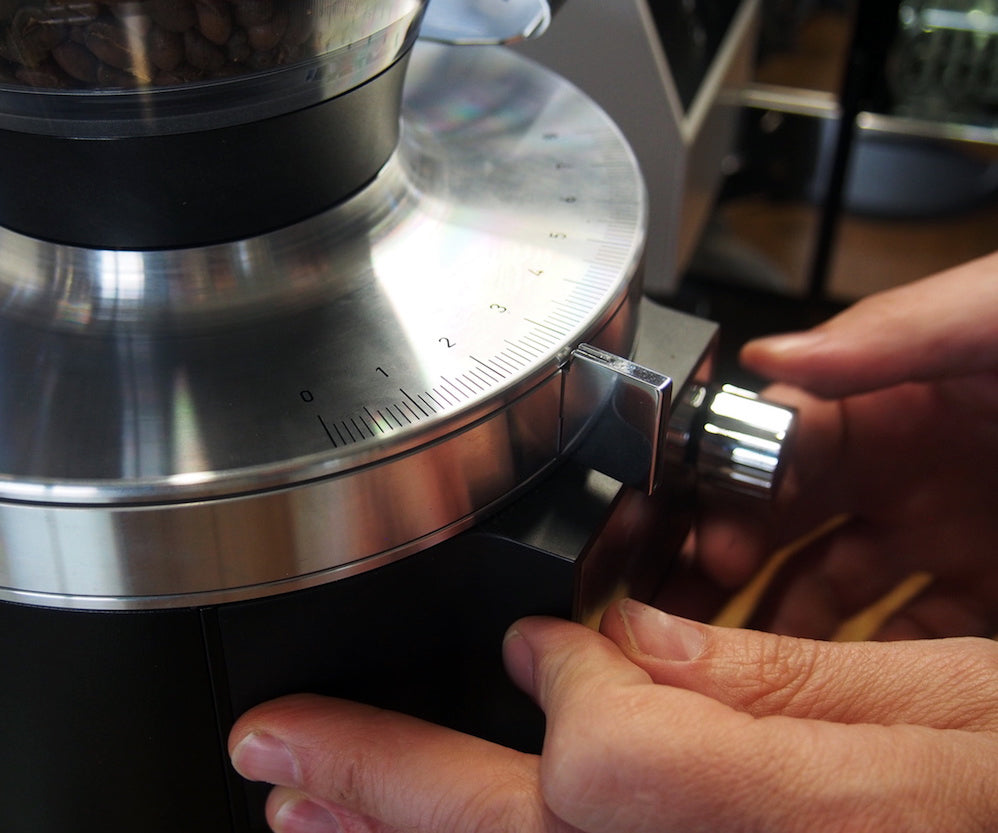By Pete Licata.
As part of my Espresso Grinder Series, the Malkonig E65s was put through its paces, assessed on its design, functionality and performance.
It was dialled into a 20g dose and a grind which achieves an output weight of 40g in 25-27 seconds. Across 20 extractions, we looked at the following;
- Dose variance from the dialled setting
- Max production rating
- Amount of uncontrollable wastage (such as grinds falling during dosing, etc)
- Amount of coffee retained in burr set
There are some very positive features of the Malkonig E65s, especially in its design. When it comes to functionality and performance, we have a very similar product to previous generations. The E65s is a step in a good direction for Malkonig and is an improvement upon its old K30 technology. I would score this grinder 7/10.
DESIGN
With a polished exterior finish, LED screen, heavy matte plastic casing, metallic grind collar, and the new and improved bean hopper, my initial impression of the E65s was quite high.
The dosing chute has been redesigned to be adjustable, or even removed, in order to facilitate the grinds falling into an ideal placement in the portafilter basket. The afformentioned hopper is robust and sturdy feeling, and removing it is a breeze. The LED screen and adjustment wheel are clean and easy to use, as is the refined portafilter holder. The grinds from this grinder are fluffy and light, eliminating the clumps produced by some of the previous models from Malkonig.
Additionally, this grinder has a very small footprint on your bench, roughly 19x28cm. This footprint is ideal for smaller cafes, or even just to maximise the use of available space. It’s also very quiet when in operation. Up to six programmable dose timings may be saved, and almost all features, with the exception of the 65mm flat burrs, have been refined from the original K30 model.
PERFORMANCE
The first thing to highlight is dose consistency. The target dialled in dose was 20g, and even setting this dose amount was quite tricky. Since it grinds very quickly, the smallest adjustment (0.05 second) would change the dose almost half a gram, so it took a bit of tweaking to get the dose right at 20 grams. After this, the dosing from the grinder had a good amount of swing, from -0.5 to +0.7 away from the desired dose of 20g. Of the 20 shots, the exact dose was achieved twice (10%), and within +/- 0.2g, only 9 times (less than 50% of attempts). So, if you are a café that weighs and adjusts the dose of every handle of coffee, this grinder will not change the way you work.
As my tests proceeded, the grind needed adjusting by the 5th shot. I generally wouldn’t associate this shift with the burrs heating excessively, as I was pulling the shots at a rather slow pace (once every two minutes). All of the grinders tested were seasoned by grinding a minimum of 2kg prior to use, so the burrs “settling in” should not have been a factor. Regardless, the grind needed adjusting three times over 20 shots in order to maintain the original shot parameters.
When looking at the grind adjustment collar, there is a locking mechanism at the rear of the grinder to prevent the collar from shifting. The placement of this lock is a little difficult to reach, especially if you have other equipment close by. When locked, the collar still has a good amount of wiggle room, which perhaps was part of the need for adjustments. Additionally, when this lock is engaged the grind collar seems to turn into a stepped grind of sorts. Whether this is the intended functionality of the grind collar or not remains to be seen. That easily removable bean hopper must be replaced with a small peg in a specific slot, which can be a pain the first time you do it. Also, as I was working it was quite easy to bump the LED function wheel, which would change my dose timing to a different pre-set.
The E65s also has a tendency to move a bit as you use it (or adjust the grind) since the base is so narrow. Add in a relatively light weight (which is nice when you have to move the thing) and movement easily occurs, so some sort of non-slip material underneath wouldn’t hurt.
The last few things I’d like to point out are:
- The overall amount of coffee held in the burr set is roughly 10g, and the amount held above the burr set but below the hopper gate was 40g. This amount being held is quite good, and especially the amount held in the burr set is very little for horizontally oriented burrs.
- During my dial in and 20 extractions, I found there to be only 0.5g of uncontrollable waste. This of course doesn’t count purging the grinder on grind adjustments, though since the burr set retains around 10g a purge should be less wasteful in general.
- You can tell a LOT was thought about in the design of this grinder, and the details do lead to an overall better experience than other Malkonig espresso grinders.



